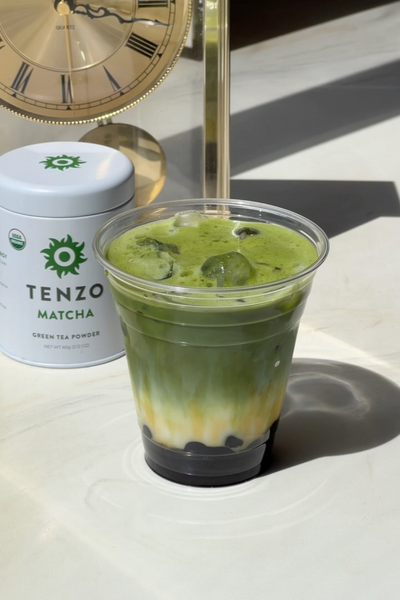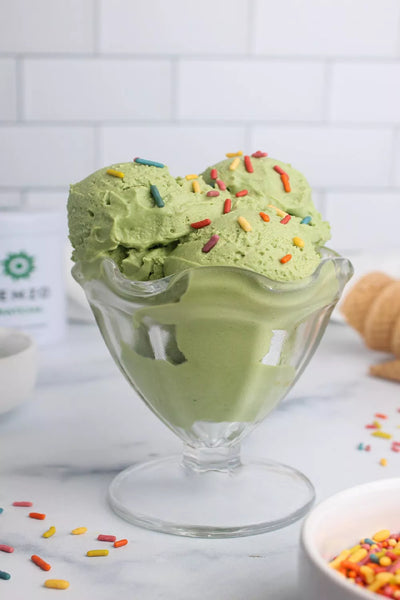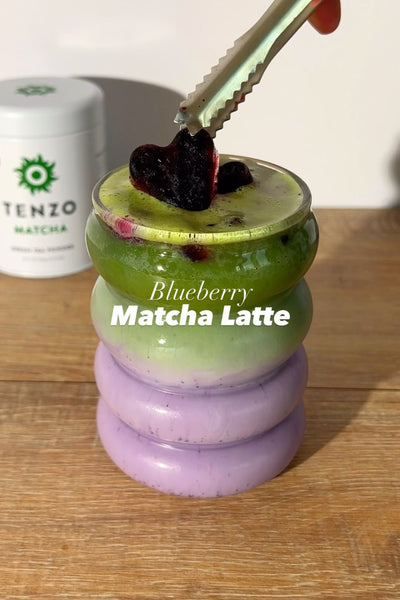Green Tea: The History, Green Tea Benefits, and More!

The Complete Guide on How to Choose the Best Green Tea
For millennia, people have been debating over the best green tea. Which one has the most health benefits? Which one tastes the best? Which one is the true OG?? All over the world, green tea connoisseurs argue over how strong to make a cuppa; whether to use loose-leaf, powdered or bagged is best; and if you’re really getting more bang for your buck on the top-shelf green tea or matcha.
Modern-day tea-drinkers aren't the only ones to be stumped by the age-old--or should we say millennia-old--question on how to choose the best tea. Almost as soon as Japan began cultivating green tea, the competition began between the two green tea growing sites, Uji and Toganoo.
When Japanese Zen monk Eisai gave a cup of green tea to a top-ranked and horribly hung-over shogun, the shogun became an instant advocate of the healing properties of green tea. (Unlike coffee, green tea is hydrating!) The regular practice of drinking green tea soon became all the rage among the cultural elite of Japan. The wealthiest of nobles even started putting on tea competitions to decide which green tea was truly best.
Which green tea was the winner of them all? Well, I suppose it depends on what you’re looking for...
A Brief History of Japanese Green Tea
Before there were green tea fields in Japan, they were first in, you guessed it, Japan’s frenemy for millennial, China. Japanese Monk Eisai brought green tea tree seeds from China to Japan in the early 12th century. Eisai was foremost concerned with its health benefits of green tea which he presumably experienced himself while studying Zen Buddhism in China.
Breaking all modern-day rules about planting non-native species, back in Japan, Eisai distributed the green tea tree seeds to some other monk buddies to plant at their respective temples in the Kyoto Prefecture of Japan. The two sites were, if you’ve been paying attention, Uji and Toganoo.
Even though the green tea saplings were from the same seeds and only growing a five-hours walk from each other, Toganoo green tea got the name honcha, meaning “real tea,” while the Uji product was labeled the hicha, meaning “non-tea.”
The choice for tea-drinkers in 12th century Japan was simple: the real stuff, or, the stuff sword-slinging wannabe samurais drink. You can take a guess as to which was the preferred green tea of the cultured classes in the 12th century…
Every Monk has their Tea...
Not only did green tea advocate and superstitious monk, Eisai, cure a wealthy shogun boy of a simple hangover by giving him a cup of hydration and caffeine, he also published a bestseller. Meaning he wrote something and the wealthy people that could read passed the copies around and loved it. This was the 13th century after all.
In the early decades of 1200, Eisai published his hit treatise on the health benefits of green tea, titled Kissa Yōjōki, roughly “Drink Tea for Health”. In it, he describes numerous green tea benefits with somewhat surprising merit. He noted that regular consumption would decrease fatigue and increase hydration (common hangover problems), reduce lupus flare-ups, and cure beriberi disease (also irritated by hangovers, come to find out). More general health benefits of green tea described were the healing of indigestion and diseases of the heart—not totally without merit, but a pretty bold claim!
Eisai was truly a diehard believer in the benefits of green tea.
(One interesting thing to note here is that green tea was probably healthier than just drinking whatever water was around as the process in making it involved boiling water, thereby sanitizing it. Clean water is always a plus, no matter what century you live in.)
So which green tea did Eisai, the Zen monk who pulls you out of hangover funks, opt for?
Sadly for us, neither. Eisai was a hippie when it came to green tea, and just wanted everyone to sip and enjoy whichever green tea they had.
And perhaps that’s for the best, because the green tea tables of Japan were about to turn.
Honcha vs Hicha
By the 1500s, the honcha vs hicha debate was old news. Of course both were in fact “real” and everyone soon realized that the Uji tea was much closer to where they all lived in Kyoto. Uji “brand” green tea quickly outpaced the Toganoo, putting hicha on top. Today, hicha is still used to denote green tea from Uji.
As the trendy green tea drink grew in popularity, so did cultivation. Eisai has long since passed away, but he would have burst with joy at the enthusiasm over green tea. For all its health benefits green tea began a whole culture, including, notably the Japanese Tea Ceremony. (possibly the world's first ASMR experience?? Please debate...)
The ins and outs of the Japanese Tea Ceremony are too much for me to cover here, but if you’re more cinematically inclined, check out the Tea Ceremony scene from Mozart in the Jungle, definitely ASMR worthy.
But big changes were arriving on the tea scene, most notably, how it was brewed.
Matcha and the Rise of Loose Leaf Tea
The biggest change to green tea consumption, to date was the 1500s change in brew methods. When most people think of green tea, they imagine a little tea bag with some dried leaves in it. But, the OG method was more like today’s matcha. (Tea ceremonies still use the traditional powdered green tea, aka, matcha.)
Fast forward 500 years—Vrrrrrr!—and, blamo, the question of which green tea is the best still haunts us.
But, we’ve got a few expert tips, from the ghost of Eisai himself.
How to Choose the Best Green Tea
We’ve all had moments where we opted for the most expensive choice on the shelf, only to find, weeks later that the brand your tea connoisseur yogi pal buys the generic middle of the road stuff that was $10 cheaper! And you try it and somehow it tastes even better than the overpriced stuff you got. Ugh.
With the renewed interest in matcha and all things health-drink, it’s worth diving into which method of brewing green tea is truly superior. And if you really want the health benefits green tea offers, which method gets you the most bang for your buck? Then of course no matter which brew process you choose, there are still so many options when it comes to buying matcha powder and green tea than ever before!
But first, which brew method is really better?
The Matcha-Green Tea Showdown
*cue cable sports theme song*
The basic thing to know about matcha vs bagged tea is the difference in taste and potency. It’s widely accepted that green tea is the bomb for your body. In the best way possible. It does have a lot going for it beyond hydration you and going you an energy boost.
All Matcha is green tea but not all green tea is Matcha. Matcha powder is what you get after green tea leaves are picked, destemmed (veins and all), and grind into a fine powder. You whisk the powder with hot water and enjoy. Green tea typically refers to loose leaf teas or bagged tea steeped in boiling water. So with matcha, you are actually consuming the green tea leaves.
And again, this is indeed the OG method. Eisai wrote Kissa Yōjōki, based on observing and drinking what we would consider Matcha. In fact, the age-old Japanese Tea Ceremonies use some of the finest made matcha today—and it comes at a premium!
We already know that steeped green tea has health benefits. Imagine the increased potency of those benefits when consuming the actual tea leaves!
But then, we’re still faced with the same paradox of choice over which matcha to drink.
If it’s all relatively the same process though, how can we tell which is the best to buy? Worry not, dear readers—you have come a mighty long way and here is the moment you’ve been waiting for: the 3 Steps in assessing matcha. to look for in matcha. Here’s a breakdown to find the right matcha for you, health benefits and all.
Step 1: The Healthiest Matcha Tea
Matcha is often referred to as a superfood, and for good reason. One teaspoon of matcha powder can be as healthy as a container of pomegranates and blueberries. There are several factors that affect the amount of health benefits that you could expect to receive from a cup of matcha tea. Factors that affect “health potency” include: the area in which the raw green tea leaves were grown; how much attention they received during the grinding process.
Unless you grow matcha yourself, it can be difficult to control these things. But there is one surefire way to know if your matcha is healthy, which brings us to the next step.
2. The Greener the Better
The best matcha green tea is the freshest. But how can you tell which matcha is the freshest??
Freshness doesn’t just mean how far from the expiration date a particular package is. When it comes to green tea, freshness is all about when the leaves were picked and how they were dried. Many matcha powders that can be found in supermarkets advertise powder that looks green but, when you open them up, you find that the powder you're about to use for the next month is actually brown (gross)! Not only does green matcha powder look better but it tastes much better, too. Would you eat brown spinach? Neither would we.
Matcha should be green. Like noticeably.
“Matcha's sweet flavor and deep green color are created by shading the tea leaves from the sun in the last weeks before plucking, increasing the chlorophyll and decreasing the tannin content of the leaves.”
3. Best Organic Matcha Powder
Only select matcha tea that is 100 percent natural and organic. So many of the green teas and matcha brands on the market are filled with either preservatives, unnatural sugars, or a combination of both of these things. In general, these are things that are smart to stay away from but this is even truer when it comes to matcha powder. So many of the health benefits and natural wonders of green tea are eroded by the inclusion of harmful additives, which makes it critically important to only consume green tea and matcha that is organic and free of all these harmful toxins.
Time for a little bit of Q & A!
What are the differences between Matcha and Green Tea?
Matcha is powder and Green Tea is steeped tea. But, there are a number of evident differences.
While they are both similar as they come from green tea leaves. They have noticeable differences in colors, flavors, textures, and especially preparation methods that make a huge difference. There are differences in their nutritional benefits, as well.
So how do Matcha Tea Powder and Green Tea Powder differ from each other?
Green Tea and Matcha have differences in Color
- Ordinary green tea would look a little dull brown.
- Whereas, Matcha has a glowing and vibrant color. It just looks so energetic at first glance.
So what makes Matcha color lively?
In one word, that's chlorophyll. It's the natural and powerful polyphenol green pigment present in all green plants. Matcha has high levels of chlorophyll, which makes it look shining green.
Why do people prefer ceremonial grade Matcha?
It’s preferred because it doesn't require any additional sweetener to enjoy the drink. It's already so rich in taste that you just don't even need any sort of dairy products with it.
Is Matcha texture any better than green tea?
- Green tea powder would feel grainy and rough, like crushed-up leaves.
- Matcha powder is super smooth, like the finest talc powder
So how come Matcha is so different from green tea?
Great question! Especially, if they are from similar green tea leaves, then what really changes in processing that makes Matcha much more desirable, beneficial and premium?
So here's the secret!
Matcha Green Tea Powder uses only the finest green tea leaves. These leaves are hand-harvested. All the stems and veins are carefully removed, to later stone-ground into Matcha powder.
In case of simple green tea, it's merely made from the leaf in hot water.
How is the preparation of Matcha or Green tea, any different?
- For the best experience, mix your matcha with water that’s less than 175' Fahrenheit or 79' Celsius.
- Normal green tea is nutritionally good, but not as beneficial as Matcha. On top of that, most standard green tea is boiled up to 100' Celsius, that's 212' Fahrenheit. That abruptly kills most of its nutritional value!
What are the nutritional value differences between Matcha and Green Tea?
Everyone unanimously agrees, a single cup of Matcha provides 10 to 15 times more nutritional value (depending upon Matcha quality grade) than a cup of regular steeped green tea.
How can Matcha provide so much nutrition?
Simple, Matcha is a finely grained form of the full premium leaves. In comparison, green tea is just a couple of standard crushed leaves in hot water.
How are Matcha and Green Tea different nutritionally?
Both have Epigallocatechin Gallate, also known as EGCG. EGCG is a crystalline compound that is extremely powerful antioxidants.
Research has proven it has multiple health benefits; it has shown to help in curing cancer. Here's one of the credible and detailed research.
Just so if you don't know, antioxidants get rid of all the bad toxins in your body. This is the biggest factor for why we gain weight, get sick and acquire other severe diseases.
So increased metabolism and improved physical stamina is just the tip of the iceberg of benefits!
In every one gram:
- Matcha has 134 milligrams of ECGC's.
- Green Tea has only 63 milligrams of it.
How much of other Polyphenols do Matcha and Green Tea have?
Tannins are a natural micronutrient, found in plants, teas, and wines.
In every one gram:
- Matcha has 99 milligrams of Tannins.
- Green Tea has 7 milligrams of it.
Does Matcha have as many Amino Acids as Green Tea has?
Absolutely yes!
Both have L-theanine, which is an amino acid that calms the brain and improves cognitive abilities. You get to experience more creativity, improved memory, and a higher level of attention.
So yes, it has all the caffeine energy-boosting benefits, but without the crash!
In every one gram:
- Matcha has 45 milligrams of L-theanine.
- Green Tea has only 3 milligrams of it.
What's the count of antioxidants in Matcha and Green Tea?
Green tea has 137 times less of antioxidants than Matcha. That's why Matcha is increasingly becoming the preferences of masses.
Do yourself a favor and try premium Matcha. We at Tenzo Tea, offer the highest-quality ceremonial grade Matcha.
Thousands of Tenzo Tea lovers just can't be wrong! Here are the top benefits of having Matcha tea.
Try Tenzo Tea ones, and you'll be happy you tasted the real Matcha!
Where can I find great Matcha recipes?
Glad, you asked!
We have prepared an amazing handbook for best matcha recipes.
So you will never really run out of Matcha ideas. Be it preparing a Matcha Latte or Lemonade, we have all the popular drink and food recipes.
What are Green Tea Leaves?
Green Tea leaves come from the green tea plant. The scientific name for the green tea plant is the "Camilia Senensis". Green tea leaves are known across the world for their powerful health benefits and a wide variety of delicious drinks.
Where did green tea leaves originate?
As mentioned above, green tea leaves first turned up in the history books in China in 2737 B.C - yeah, that's old. Throughout the course of history green tea leaves have spread to many different parts of Asia and the rest of the world.
Where are the best green tea leaves made nowadays?
Nowadays, some of the best tea producing regions in the world are outside of China. One such region, the Uji region of Japan has become particularly famous for their green tea fields and production. Green tea farming in the Uji region began in the 9th century A.D. and has been perfected ever since. Today, many regions of Japan are known for producing exceptional green tea leaves. This makes Japan the best green tea producing country in the entire world.
Why should you drink Green Tea Leaves?
Well, obviously I'm a little biased, but let's be real. Green tea is extremely good for your body. It helps in so many ways, you can read more about them on our green tea health benefits page. For starters, it's the healthiest way to get a boost of energy. It's also got an amazing amino-acid called L-theanine that literally changes your brain waves from a Beta state (active) to the Alpha state (calm and focused). There are so many more benefits listed on our Health Benefits page, so go and check it out!
A Brief Interlude on Green Tea Quality...
I need everyone to get this through your heads: not all green tea is created equal. For those of you still drinking 0.50c bags of Lipton green tea, consider yourself warned. This is now the future. Instead of 2mg of caffeine, some sugar, and whatever other chemicals they put in that bag, you can now drink matcha., aka the Gucci of green teas.
With matcha, you get between 5-10x more benefits that traditional steeped green teas. But hey, I don't think you'd be reading this interview if you didn't know that already!
Image Credit: https://unsplash.com/photos/f3uWanPu_rU










